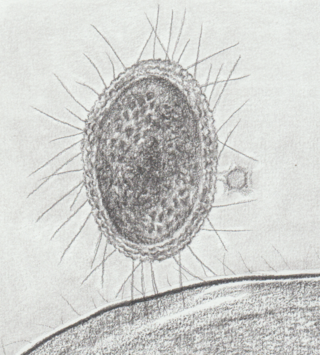Related Research Articles
The Geobacteraceae are a family within the Thermodesulfobacteriota.

Desulfovibrionales are a taxonomic order of bacteria belonging to the phylum Thermodesulfobacteriota, with four families. They are Gram-negative. The majority are sulfate-reducing, with the exception of Lawsonia and Bilophila. All members of this order are obligately anaerobic. Most species are mesophilic, but some are moderate thermophiles.
The Syntrophobacterales are an order of Thermodesulfobacteriota. All genera are strictly anaerobic. Many of the family Syntrophobacteraceae are sulfate-reducing. Some species are motile by using one polar flagellum.
Desulfovibrionaceae is a family of bacteria belonging to the phylum Thermodesulfobacteriota.

The Thermodesulfobacteriota are a phylum of thermophilic sulfate-reducing bacteria.
The Myxococcota are a phylum of bacteria known as the fruiting gliding bacteria. All species of this group are Gram-negative. They are predominantly aerobic genera that release myxospores in unfavorable environments.

Bacterial phyla constitute the major lineages of the domain Bacteria. While the exact definition of a bacterial phylum is debated, a popular definition is that a bacterial phylum is a monophyletic lineage of bacteria whose 16S rRNA genes share a pairwise sequence identity of ~75% or less with those of the members of other bacterial phyla.

'The All-Species Living Tree' Project is a collaboration between various academic groups/institutes, such as ARB, SILVA rRNA database project, and LPSN, with the aim of assembling a database of 16S rRNA sequences of all validly published species of Bacteria and Archaea. At one stage, 23S sequences were also collected, but this has since stopped.
The "Aigarchaeota" are a proposed archaeal phylum of which the main representative is Caldiarchaeum subterraneum. It is not yet clear if this represents a new phylum or a Nitrososphaerota order, since the genome of Caldiarchaeum subterraneum encodes several Nitrososphaerota-like features. The name "Aigarchaeota" comes from the Greek αυγή, avgí, meaning "dawn" or "aurora", for the intermediate features of hyperthermophilic and mesophilic life during the evolution of its lineage.
Syntrophus is a Gram negative bacterial genus from the family of Syntrophaceae.

DPANN is a superphylum of Archaea first proposed in 2013. Many members show novel signs of horizontal gene transfer from other domains of life. They are known as nanoarchaea or ultra-small archaea due to their smaller size (nanometric) compared to other archaea.

Atribacterota is a phylum of bacteria, which are common in anoxic sediments rich in methane. They are distributed worldwide and in some cases abundant in anaerobic marine sediments, geothermal springs, and oil deposits. Genetic analyzes suggest a heterotrophic metabolism that gives rise to fermentation products such as acetate, ethanol, and CO2. These products in turn can support methanogens within the sediment microbial community and explain the frequent occurrence of Atribacterota in methane-rich anoxic sediments. According to phylogenetic analysis, Atribacterota appears to be related to several thermophilic phyla within Terrabacteria or may be in the base of Gracilicutes. According to research, Atribacterota shows patterns of gene expressions which consists of fermentative, acetogenic metabolism. These expressions let Atribacterota to be able to create catabolic and anabolic functions which are necessary to generate cellular reproduction, even when the energy levels are limited due to the depletion of dissolved oxygen in the areas of sea waters, fresh waters, or ground waters.

The candidate phyla radiation is a large evolutionary radiation of bacterial lineages whose members are mostly uncultivated and only known from metagenomics and single cell sequencing. They have been described as nanobacteria or ultra-small bacteria due to their reduced size (nanometric) compared to other bacteria.

NC10 is a bacterial phylum with candidate status, meaning its members remain uncultured to date. The difficulty in producing lab cultures may be linked to low growth rates and other limiting growth factors.
The Genome Taxonomy Database (GTDB) is an online database that maintains information on a proposed nomenclature of prokaryotes, following a phylogenomic approach based on a set of conserved single-copy proteins. In addition to resolving paraphyletic groups, this method also reassigns taxonomic ranks algorithmically, updating names in both cases. Information for archaea was added in 2020, along with a species classification based on average nucleotide identity. Each update incorporates new genomes as well as automated and manual curation of the taxonomy.
Bdellovibrionota is a phylum of bacteria.
The Desulfocapsaceae are a family of Thermodesulfobacteriota.
References
- ↑ Parks, DH; Chuvochina, M; Waite, DW; Rinke, C; Skarshewski, A; Chaumeil, PA; Hugenholtz, P (November 2018). "A standardized bacterial taxonomy based on genome phylogeny substantially revises the tree of life". Nature Biotechnology. 36 (10): 996–1004. bioRxiv 10.1101/256800 . doi:10.1038/nbt.4229. PMID 30148503. S2CID 52093100.
- ↑ Parks, DH; Chuvochina, M; Chaumeil, PA; Rinke, C; Mussig, AJ; Hugenholtz, P (September 2020). "A complete domain-to-species taxonomy for Bacteria and Archaea". Nature Biotechnology. 38 (9): 1079–1086. bioRxiv 10.1101/771964 . doi:10.1038/s41587-020-0501-8. PMID 32341564. S2CID 216560589.
- ↑ Chaumeil, PA; Mussig, AJ; Hugenholtz, P; Parks, DH (15 November 2019). "GTDB-Tk: a toolkit to classify genomes with the Genome Taxonomy Database". Bioinformatics. 36 (6): 1925–1927. doi: 10.1093/bioinformatics/btz848 . PMC 7703759 . PMID 31730192.
- ↑ Almeida, Alexandre; Nayfach, Stephen; Boland, Miguel; Strozzi, Francesco; Beracochea, Martin; Shi, Zhou Jason; Pollard, Katherine S.; Sakharova, Ekaterina; Parks, Donovan H.; Hugenholtz, Philip; Segata, Nicola; Kyrpides, Nikos C.; Finn, Robert D. (20 July 2020). "A unified catalog of 204,938 reference genomes from the human gut microbiome". Nature Biotechnology. 39 (1): 105–114. doi: 10.1038/s41587-020-0603-3 . ISSN 1087-0156. PMC 7801254 . PMID 32690973.
- ↑ Nayfach, Stephen; et al. (9 November 2020). "A genomic catalog of Earth's microbiomes". Nature Biotechnology. 39 (4): 499–509. doi: 10.1038/s41587-020-0718-6 . PMC 8041624 . PMID 33169036.
- ↑ "GTDB release 08-RS214". Genome Taxonomy Database . Retrieved 10 May 2023.
- ↑ "ar53_r214.sp_label". Genome Taxonomy Database . Retrieved 10 May 2023.
- ↑ "bac120_r214.sp_label". Genome Taxonomy Database . Retrieved 10 May 2023.
- ↑ "Taxon History". Genome Taxonomy Database . Retrieved 10 May 2023.